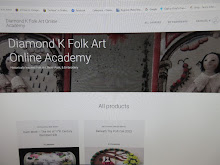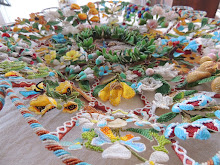 Many of you know that I have a particular affinity for early painted basket purses, and have collected them, and the images with them in it, for several years now. Well occasionally I will get lucky and find something special on eBay, and this week was no exception! The above image was listed as a daguerreotype, which I knew directly it was not. I figured it was possibly a tin type copy of an earlier daguerreotype, and the precious girl was holding a spectacular painted basket purse, so I had to have it!
Many of you know that I have a particular affinity for early painted basket purses, and have collected them, and the images with them in it, for several years now. Well occasionally I will get lucky and find something special on eBay, and this week was no exception! The above image was listed as a daguerreotype, which I knew directly it was not. I figured it was possibly a tin type copy of an earlier daguerreotype, and the precious girl was holding a spectacular painted basket purse, so I had to have it! When it arrived yesterday, I opened the case and took it out to clean the glass, only to discover something wonderful and fascinating that I had never seen before. Sandwiched between 2 clear glass plates, and affixed directly onto the back of the ornate brass preserver, was the perfect rendition of our little lady, but not on tin, or glass...or even leather like I have heard of before~ but a piece of felted cloth!
When it arrived yesterday, I opened the case and took it out to clean the glass, only to discover something wonderful and fascinating that I had never seen before. Sandwiched between 2 clear glass plates, and affixed directly onto the back of the ornate brass preserver, was the perfect rendition of our little lady, but not on tin, or glass...or even leather like I have heard of before~ but a piece of felted cloth! This i s a close up view of the back of the cloth~ it has a felted nap, with the weave clearly visible. In fact, the weave is also visible from the front~ that is what makes the little bumpy texture in the second picture above. Isn't that just amazing?!
This i s a close up view of the back of the cloth~ it has a felted nap, with the weave clearly visible. In fact, the weave is also visible from the front~ that is what makes the little bumpy texture in the second picture above. Isn't that just amazing?! I had read about images on leather, very rare, but couldn't for the life of me remember what they were called...Impressed into the side bevel of the brass preserver I could read " HOLMES, BOOTH & HAYDENS SUPERFINE" on one side, and "WAT......EY CONN 12" on the other. After a little research, I found that Holmes, Booth & Haydens was founded in Waterbury Connecticut in 1853 as a manufacturer of photographic equipment basically. VERY interesting! But I couldn't find anything referring to my image on cloth, so I called Dr. Dusan Stulik at the Getty Conservation Institute in Los Angeles Ca, and got alllll my questions answered!
I had read about images on leather, very rare, but couldn't for the life of me remember what they were called...Impressed into the side bevel of the brass preserver I could read " HOLMES, BOOTH & HAYDENS SUPERFINE" on one side, and "WAT......EY CONN 12" on the other. After a little research, I found that Holmes, Booth & Haydens was founded in Waterbury Connecticut in 1853 as a manufacturer of photographic equipment basically. VERY interesting! But I couldn't find anything referring to my image on cloth, so I called Dr. Dusan Stulik at the Getty Conservation Institute in Los Angeles Ca, and got alllll my questions answered! He identified my image as a "pannotype", and that the Greek word pannos actually translated to 'cloth'. The process was invented in 1853, and only in use until 1860. They were initially hailed as the first 'unbreakable' images, as up until then, you could either have a daguerreotype or ambrotype photograph made~ the dag was on a silver plate and very fragile, and the ambrotype was on a glass plate. Not many have survived due to the fact that the emulsion cracks over time and the cloth disintegrates, so I am overjoyed to have this one, and in near perfect condition!
He identified my image as a "pannotype", and that the Greek word pannos actually translated to 'cloth'. The process was invented in 1853, and only in use until 1860. They were initially hailed as the first 'unbreakable' images, as up until then, you could either have a daguerreotype or ambrotype photograph made~ the dag was on a silver plate and very fragile, and the ambrotype was on a glass plate. Not many have survived due to the fact that the emulsion cracks over time and the cloth disintegrates, so I am overjoyed to have this one, and in near perfect condition!The technical specifics of how a pannotype was made are very involved and fascinating, as described by Marc Osterman in his book on Pannotypes~
"These direct positive collodion images were made on glass and transferred onto a secondary support material by placing the glass plate bearing the image in an acidified water bath that caused the collodion film to shrink. The secondary support was then placed int the water and the two were taken out of the bath with in image in contact with the surface of the secondary support. The back of the support was then pressed against the glass with a squeegee and the plate. The back of the plate was then gently heated until the image and support fell from the glass. The images were transferred onto black oil cloth, patent leather and black enameled paper"
Dr. Stulik said he has them also on wood, and now I have this felted cloth one~ just amazing to me~ what invention was hatched to try and preserve the human image! And just look at that basket~ painted with FRUIT! A double plus for me to find, since I could not tell from the auction picture what was there~ I assumed a floral arrangement like so many others. NOT! There are apples and a pear~ wonderful wonderful!
 Was Martha around in
Was Martha around in 
 But having money was not an excuse for frivolity and waste~ this dress has been made up of so many little pieces fit perfectly together, I wonder if it was made up from the
But having money was not an excuse for frivolity and waste~ this dress has been made up of so many little pieces fit perfectly together, I wonder if it was made up from the 






 Thought you would enjoy this~ a current picture of the Rufus Lincoln estate in
Thought you would enjoy this~ a current picture of the Rufus Lincoln estate in 















 Wonderful early
Wonderful early  I really love this bottom view~ if you click on and enlarge it, you will notice the wear to the wood on the inner sides. From this, we can tell which shoe was right and left, and that this little person walked with great ease in them on paved streets, to wear down the wood in this pattern.
I really love this bottom view~ if you click on and enlarge it, you will notice the wear to the wood on the inner sides. From this, we can tell which shoe was right and left, and that this little person walked with great ease in them on paved streets, to wear down the wood in this pattern. 





















